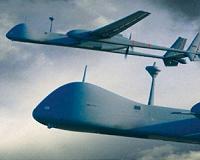| . |  |
. |
Tel Aviv, Israel (UPI) Feb 22, 2009 Israel Aerospace Industries' unveiling of a unique long-range unmanned aerial vehicle that can reach Iran is a big technological breakthrough for a defense industry that has carved a niche for itself in the global arms market. The 4.5-ton Heron TP, dubbed the Eitan, which is Hebrew for "strong," is 79 feet long. It has a wingspan of 86 feet -- about the size of a Boeing 737 airliner - and stay aloft for 20 hours at high altitude, a capability Israeli UAVs have hitherto lacked. Powered by a 1,200-horsepower turbojet engine, it has a maximum altitude of 40,000 feet and can carry hundreds of pounds of equipment, such as high-resolution cameras and electronic systems and presumably weapons. The aircraft, the largest UAV in operational service anywhere in the world, made its debut Sunday at the Israeli air force's big Tel Nof base in central Israel where UAV squadrons operate the Samson and Delilah craft. The air force declines to specify what missions the Eitan will fly, or whether it was designed for use against Iran. But state-owned IAI, the flagship of Israel's defense industry, says it has the capability of reaching the Gulf. Defense officials said the Eitan could be used for a variety of missions, such as surveillance and electronic jamming. Retired Gen. Shlomo Bron, now a security specialist with the Institute for National Security Studies at Tel Aviv University, hails the Eitan as a breakthrough. "Its staying power and the altitude it can reach means it is able to cover ground continuously and is able to cover large territory," he said. Israel's defense industry has emerged as a world leader in UAV technology and exports the systems to a dozen countries, including the United States which has deployed them in Afghanistan and Iraq. Five of the NATO members fighting in those theaters use Israeli-designed UAVs. France deploys the Heron, the Eitan's smaller predecessor, and is expected to acquire the new system. The British use the Hermes 450 built by Israel's Elbit Systems. Elbit recently announced the development of the Hermes 900, with longer endurance, higher ceiling and advanced satellite communications. It, too, is reported to be able to reach Iran. The Israeli navy plans to use unmanned craft on counter-terrorism missions along the Mediterranean coast. At least two systems have been acquired, including one known as the Protector, developed by Rafael Advanced Systems Ltd. The Israeli defense industry has been undergoing profound change in recent years, reflecting developments in military doctrine and in the nature of the military threats. In January, the government announced it would stop covering the deficit of Israel Military Industries, which had specialized in manufacturing guns and ammunition such as Uzi submachine guns, artillery barrels and mortars. This is now deemed to be part of the traditional arms industry that has become non-competitive. Instead, the primary focus has switched to the high-tech sector, which has helped cushion the economy during the global recession and is a major factor in economic growth. Precision weaponry, electronic systems and miniaturization, including robotics, is now the primary focus. Israel claims it's the third largest defense equipment exporter in the world, even though it is restricted from selling systems that contain U.S. components. IAI had to drop a $2 billion sale of Phalcon early warning aircraft to China because the Pentagon blocked it for that reason. According to official figures, despite a drop in defense exports of 18.5 percent in 2009, the value of export sales rose to $6.75 billion -- up from $6.3 billion in 2008. The Israeli industry has frequently developed specialties because of particular problems the military encountered in its countless operations against its many foes over the years. As an example, it was the need to find a counter to Soviet-designed missiles that shot down a quarter of the air force in the first days of the 1973 war against Egypt and Syria that led the Israelis into developing UAVs. Within two decades they were the acknowledged masters of that specialty. The army's problems in urban fighting during the Palestinian uprisings, where the use of armor was greatly restricted, led to the development of lightweight armor for small vehicles such as jeeps to protect their crews. The U.S. wars in Iraq and Afghanistan produced armor exports totaling $2.3 billion.
Share This Article With Planet Earth
Related Links UAV News - Suppliers and Technology
 Israel Commissions One Ton UAV Bomber
Israel Commissions One Ton UAV BomberJerusalem (AFP) Feb 21, 2010 A new drone that can remain airborne for more than 24 hours and reach as far as Iran was added Sunday to the Israeli air force's arsenal, the military said. Described by the army as a "technological breakthrough" the Eitan - which means strong in Hebrew - is a Heron-TP type drone with a wingspan of 26 metres (85 feet), similar to that of the Boeing 737. It is 24 metres (79 feet) long, ... read more |
|
| The content herein, unless otherwise known to be public domain, are Copyright 1995-2010 - SpaceDaily. AFP and UPI Wire Stories are copyright Agence France-Presse and United Press International. ESA Portal Reports are copyright European Space Agency. All NASA sourced material is public domain. Additional copyrights may apply in whole or part to other bona fide parties. Advertising does not imply endorsement,agreement or approval of any opinions, statements or information provided by SpaceDaily on any Web page published or hosted by SpaceDaily. Privacy Statement |